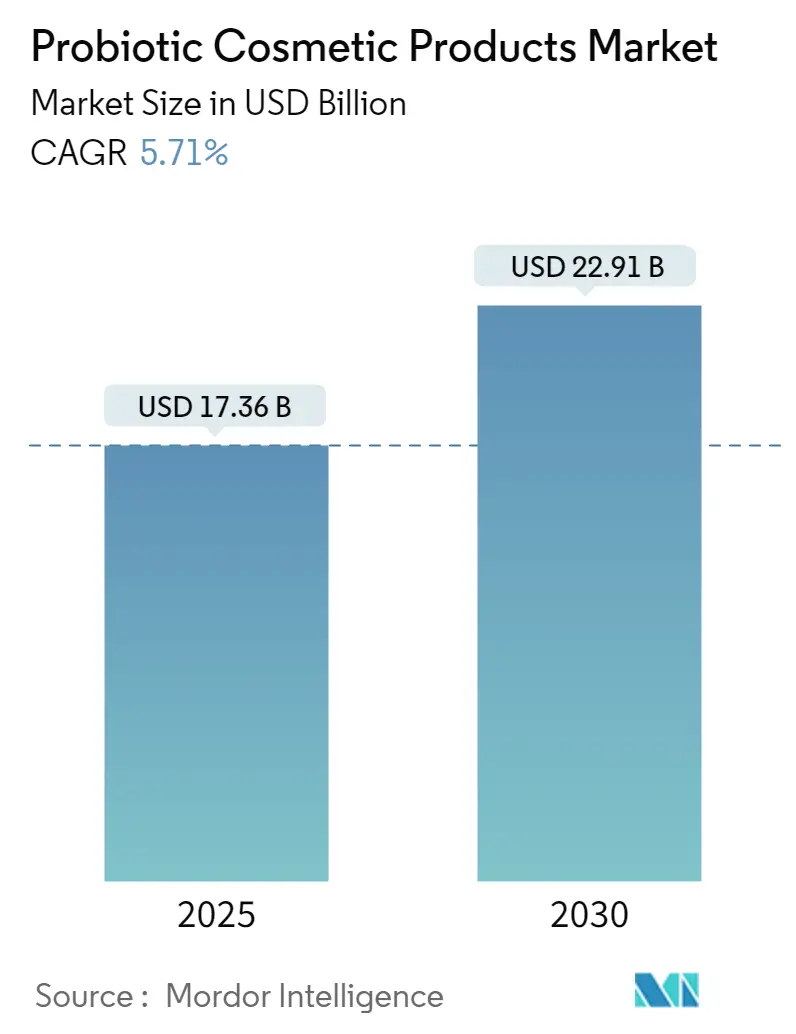
| Study Period | 2019 - 2030 |
| Market Size (2025) | USD 17.36 Billion |
| Market Size (2030) | USD 22.91 Billion |
| CAGR (2025 - 2030) | 5.71 % |
| Fastest Growing Market | Asia Pacific |
| Largest Market | North America |
| Market Concentration | Low |
Major Players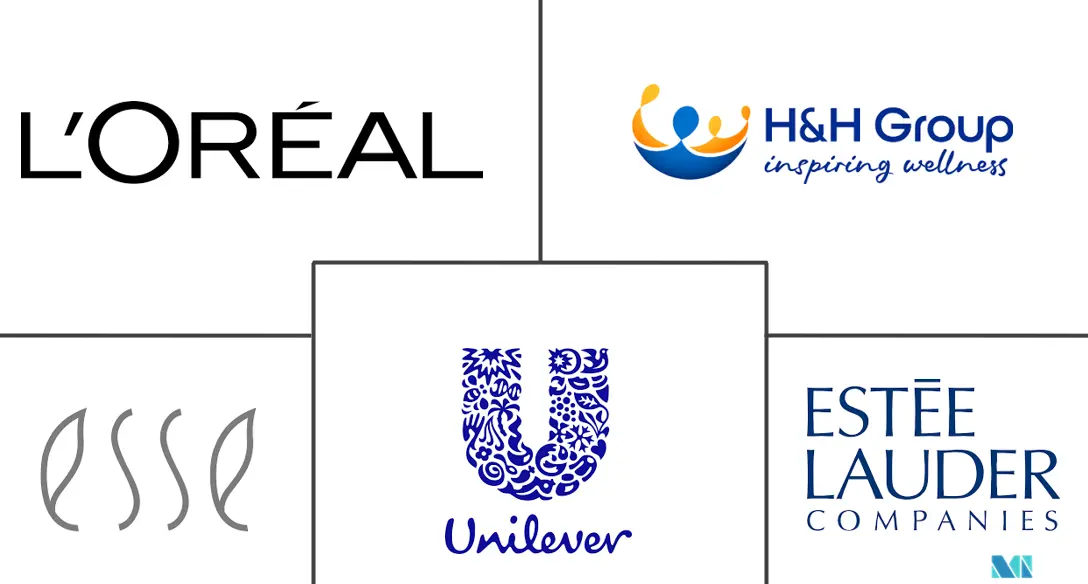
*Disclaimer: Major Players sorted in no particular order |
Probiotic Cosmetic Products Market Analysis
The Probiotic Cosmetic Products Market size is estimated at USD 17.36 billion in 2025, and is expected to reach USD 22.91 billion by 2030, at a CAGR of 5.71% during the forecast period (2025-2030).
- The rise in popularity of probiotics as a main functional ingredient is significant because of their efficiency against various skin concerns, such as acne, wrinkle, and blemishes which are anticipated to drive market growth during the study period. Furthermore, a rise in demand for natural cosmetics among various consumer groups, particularly millennials, supported by growing awareness about their clinical evidence and efficacy, has also increased the market's growth.
- Owing to the growing demand for products with natural ingredients and due to a shift towards sustainable raw materials, manufacturers of conventional cosmetics and personal care products are also introducing products with more natural ingredients, like probiotics. Future product launches are predicted to shift as a result of this trend.
- Additionally, catering to the demand, new probiotic ingredients are being launched by manufacturers specifically to use in cosmetic products. For instance, in April 2022, Probi (Lund, Sweden), in collaboration with Symrise, created a new skincare ingredient, SymFerment, a moisturizing active ingredient that the company claims is based on a byproduct of Probi's probiotic that is produced by the fermentation of Lactiplantibacillus (Lactobacillus).
- Moreover, factors such as growth in personal appearance, skin, hair, health, and wellness coupled with demand for multi-functional beauty products, which allow consumers to extract maximum value by spending on a single development, are the key trends expected to drive the probiotic cosmetic products market in the coming years.
- Also, as people spend time on social media and many fashion and skincare influencers burst onto the scene, brands could proliferate their digital presence with partnerships and increase their brand equity through promotions. This, in turn, is increasing traffic to the company websites and allowing cosmetic brands to sell direct-to-consumer with minimal focus on logistics.
Probiotic Cosmetic Products Market Trends
Increasing Demand For Multi-functionality products
- There has been an increase in demand for specialized products, including serums and creams containing probiotic skincare solutions and having multifunctional features. The young and the old population are interested in buying them because the products target common issues like wrinkles, skin tone, inflammation, and acne.
- A single cosmetic product that offers several benefits is becoming increasingly popular due to its multifunctionality, which helps consumers get the most bang for their buck with each purchase. Also, such products come in handy while traveling as they become easy to carry, reduce waste, and save money.
- Using multifunctional products is also an eco-friendly practice as it reduces plastic waste. Utilizing things with several uses helps prevent plastic waste, which is another eco-friendly approach. These factors are anticipated to drive the sales of such products, thereby boosting the growth of the entire market during the forecast period. Women are increasingly turning to multipurpose solutions with several skincare benefits because they save consumers' time and effort and make it simpler to select the best options for various uses.
- For instance, according to Cosmetica Italia, the consumption value of cosmetics and personal care products reached 79.84 billion euros (USD 85.43 billion) in 2019 and over 80 billion euros (USD 85.25 billion) in 2021. Germany consumed the largest cosmetics in 2021, valued at approximately 13.6 billion euros (USD 16.41 billion). This was followed by France and Italy, at about 12 billion euros (USD 12.72 billion) and 10.6 billion euros (USD 11.256), respectively.
- Additionally, consumers continuously seek skincare products with pure organics, such as probiotics. Furthermore, product innovation and launches will drive market growth in the coming years. For instance, in 2021, Shielded Beauty launched its skincare collection specific to improving skin health and nourishing the microbiome. Night Life "Live" Probiotic + HASerum is one of the products launched by the company, which is claimed to include live pre-and probiotics to build the skin's barrier.
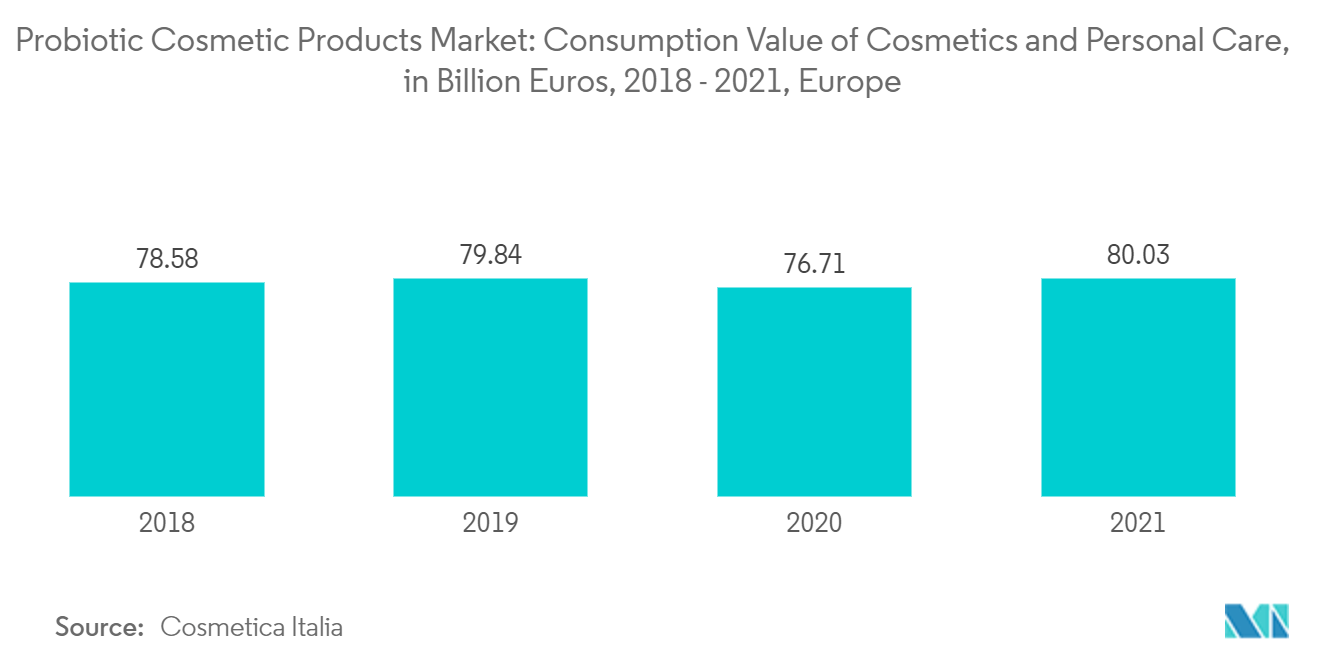
North America Holds Significant Share in the Market
- North America has witnessed an increase in the percentage of the population inclined towards healthier lifestyles, supported by a rise in demand for products that have a low impact on the environment are the major factors driving the market growth in the region. Additionally, the growing acceptance of probiotic products, including cosmetics, especially among millennials, will likely contribute to the market's growth in the coming years.
- Furthermore, awareness about the harmful effects of chemicals and synthetic products are a few factors enhancing the market's growth. As individuals become more aware of the risks posed by synthetic chemical items, they are avoiding utilizing products that include chemicals. The harmful effects on skin brought on by a few less expensive chemical product variants have raised consumer knowledge in the region and helped people comprehend the link between health and natural products, increasing demand for natural goods like probiotic cosmetics.
- In line with these factors and the growing demand for such natural and environmentally friendly products in the regions, many players are expanding their businesses into the region and launching new products to attract consumers and grab a significant market share.
- For instance, in August 2021, one of the top clean clinical skincare companies, TULA Skincare powered by probiotic extracts and superfoods, announced that it expanded its presence in North America by entering the Canadian market through Sephora.
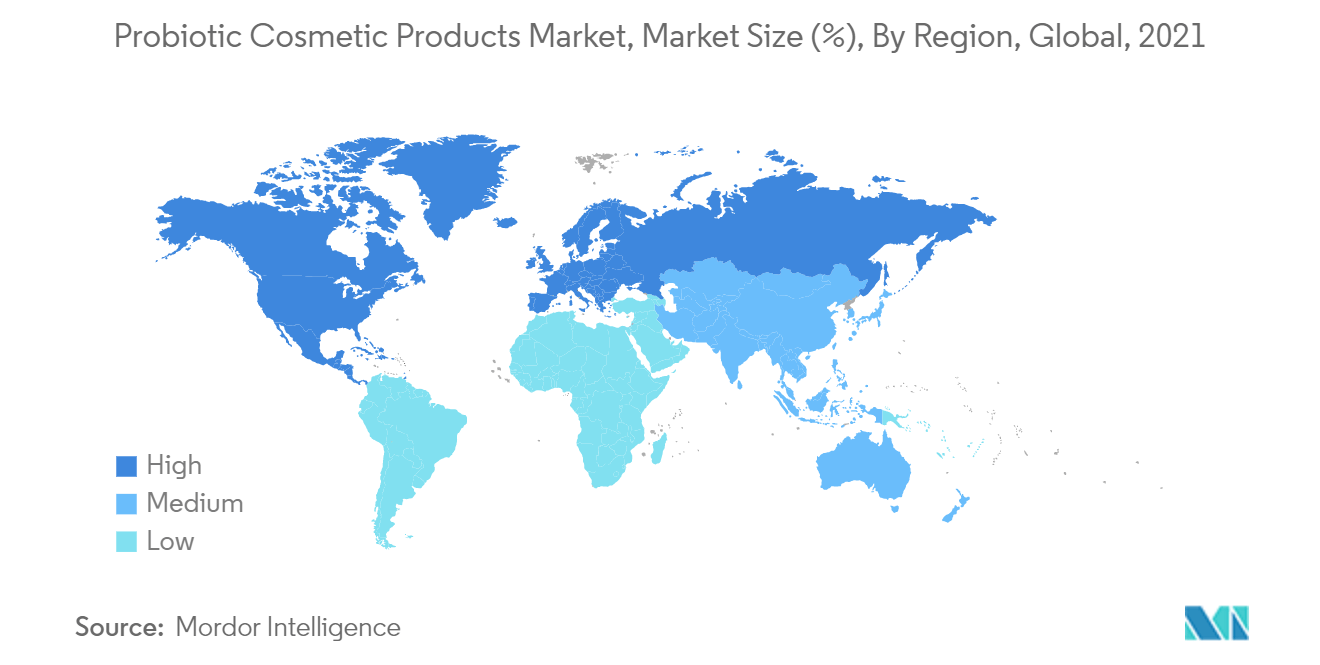
Probiotic Cosmetic Products Industry Overview
The probiotic cosmetics market is fragmented, with various regional and global players. Companies are investing in expanding their product offerings, improving functionality, and marketing activities. Due to constantly changing consumer preferences, firms must continue to innovate, operate, and develop in the market. Furthermore, organizations leverage digital and social media to promote new products and gain market share. Key players in the market include Esse Skincare, L'Oreal S.A., Unilever PLC, Estée Lauder Inc., and H&H Group.
Probiotic Cosmetic Products Market Leaders
-
Unilever PLC
-
Estée Lauder Inc
-
L'Oréal S.A.
-
Esse Skincare
-
H&H Group
- *Disclaimer: Major Players sorted in no particular order
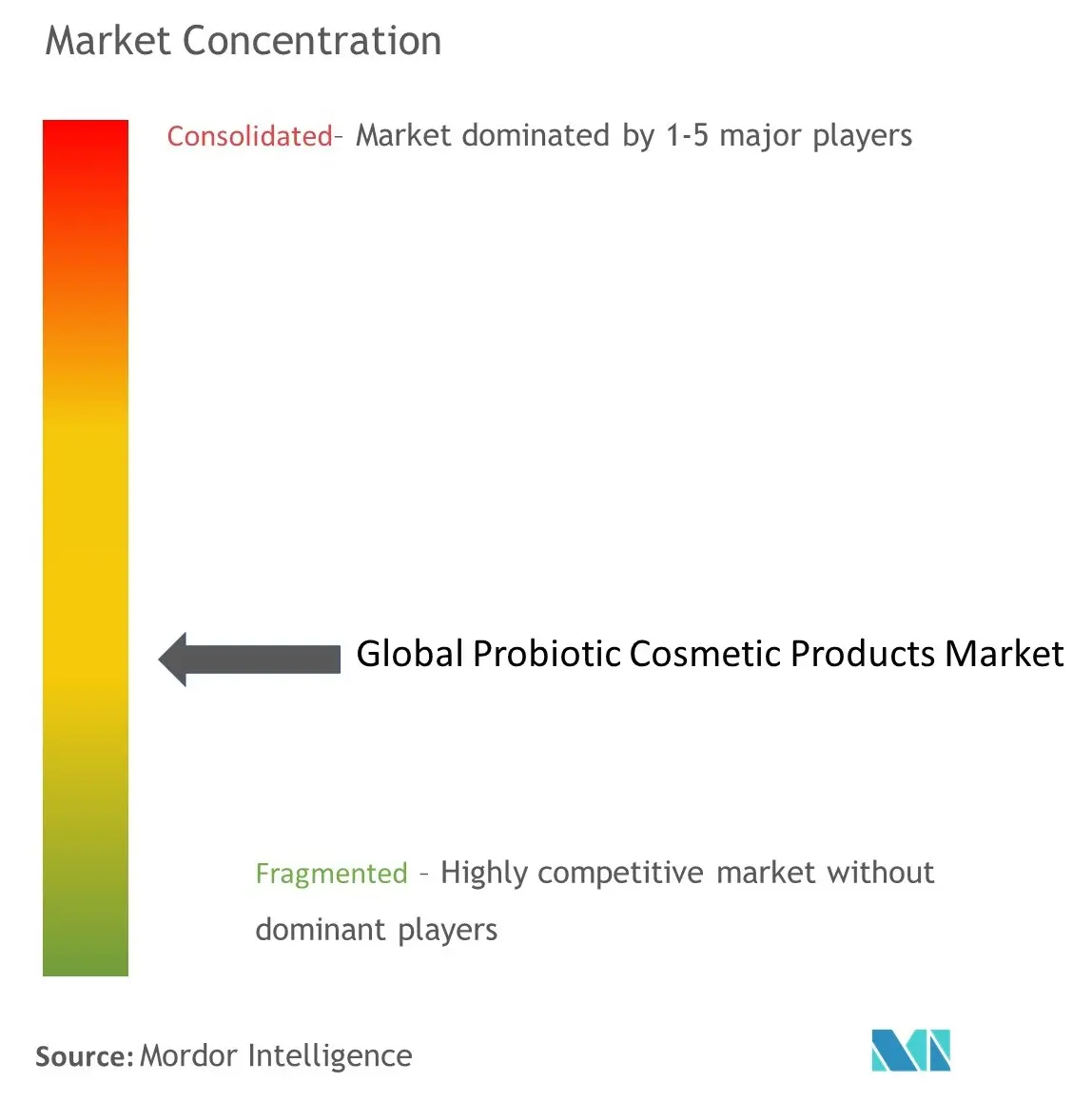
Probiotic Cosmetic Products Market News
- November 2022: A new probiotic skincare brand called Soufflé Beauty, made in Singapore, was launched into the Chinese market and introduced a wide range of products. According to Soufflé Beauty, the company does not use animal testing and is a PETA-certified cruelty-free brand. All goods are securely produced in a Singapore-based GMP-certified lab in accordance with stringent legal requirements.
- September 2021: Italian microbiome health startup Lac2Biome launched a white-label skincare blend containing live probiotics and hyaluronic acids InfiniteSkin Microbiome Serum, made from a clinically studied combination of hyaluronic acids and proprietary live probiotic strain m.biomeLiveSkin88. The product was designed using a patented two-phase delivery system where a powder-form live probiotic strain is stored and protected from moisture migration to the hyaluronic acid liquid within a 15ml vial.
- August 2021: New Zealand-based probiotics firm made its debut in cosmetics with its new skincare brand, Unconditional Skincare Co., which uses a probiotic strain naturally found in the skin. The firm recently entered the skincare space with the development of BLIS Q24, a patented micrococcus luteus strain that features the brand as the key active ingredient. Unconditional Skincare Co. is available through its official website in New Zealand and Australia.
Probiotic Cosmetic Products Industry Segmentation
Probiotic cosmetic products are beauty products that contain specific strains of probiotic microbes that are beneficial for skin health.
The probiotic cosmetic products market is segmented by product type, distribution channel, and geography. Based on product type, the market is segmented into skincare, haircare, and other product types. Based on the distribution channel, the market is segmented as specialty stores, supermarkets/hypermarkets, convenience stores, online retail, and other distribution channels. The scope includes a detailed analysis of regions including North America, Europe, Asia-Pacific, South America, and Middle East & Africa by geography.
For each segment, the market sizing and forecast have been done based on value (in USD million).
| By Product Type | Skin Care | ||
| Hair Care | |||
| Other Product Types | |||
| By Distribution Channel | Speciality Stores | ||
| Supermarkets/Hypermarkets | |||
| Convenience Stores | |||
| Online Retail | |||
| Other Distribution Channels | |||
| Geography | North America | United States | |
| Canada | |||
| Mexico | |||
| Rest of North America | |||
| Europe | Spain | ||
| United Kingdom | |||
| Germany | |||
| France | |||
| Italy | |||
| Russia | |||
| Rest of Europe | |||
| Asia-Pacific | China | ||
| Japan | |||
| India | |||
| Australia | |||
| Rest of Asia-Pacific | |||
| South America | Brazil | ||
| Argentina | |||
| Rest of South America | |||
| Middle-East and Africa | South Africa | ||
| Saudi Arabia | |||
| Rest of Middle-East and Africa | |||
Probiotic Cosmetic Products Market Research FAQs
How big is the Probiotic Cosmetic Products Market?
The Probiotic Cosmetic Products Market size is expected to reach USD 17.36 billion in 2025 and grow at a CAGR of 5.71% to reach USD 22.91 billion by 2030.
What is the current Probiotic Cosmetic Products Market size?
In 2025, the Probiotic Cosmetic Products Market size is expected to reach USD 17.36 billion.
Who are the key players in Probiotic Cosmetic Products Market?
Unilever PLC, Estée Lauder Inc, L'Oréal S.A., Esse Skincare and H&H Group are the major companies operating in the Probiotic Cosmetic Products Market.
Which is the fastest growing region in Probiotic Cosmetic Products Market?
Asia Pacific is estimated to grow at the highest CAGR over the forecast period (2025-2030).
Which region has the biggest share in Probiotic Cosmetic Products Market?
In 2025, the North America accounts for the largest market share in Probiotic Cosmetic Products Market.
What years does this Probiotic Cosmetic Products Market cover, and what was the market size in 2024?
In 2024, the Probiotic Cosmetic Products Market size was estimated at USD 16.37 billion. The report covers the Probiotic Cosmetic Products Market historical market size for years: 2019, 2020, 2021, 2022, 2023 and 2024. The report also forecasts the Probiotic Cosmetic Products Market size for years: 2025, 2026, 2027, 2028, 2029 and 2030.
Our Best Selling Reports
Probiotic Cosmetic Products Industry Report
The Probiotic Cosmetic Products industry is booming, fueled by heightened consumer awareness of probiotics' benefits in skincare and haircare, alongside a preference for natural, organic beauty solutions. Probiotics are celebrated for enhancing skin health, including boosting natural moisturizer production, combating environmental damage, and alleviating conditions like acne and rosacea. This growth is propelled by the demand for eco-friendly products free from synthetic chemicals, leading to a surge in innovative probiotic-infused cosmetics ranging from soaps to sunscreens. The market, diversified across specialty stores, online platforms, and supermarkets, is becoming more accessible. Additionally, there's a trend towards multifunctional products offering multiple benefits, meeting consumer desires for value and convenience. With the industry's pivot towards natural ingredients and probiotic benefits, further growth and innovation are anticipated. For detailed insights, Mordor Intelligence™ provides an analysis, including market share, size, revenue growth rate, and a forecast outlook, available as a free report PDF download.




